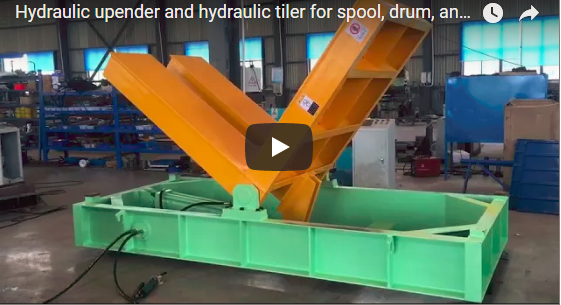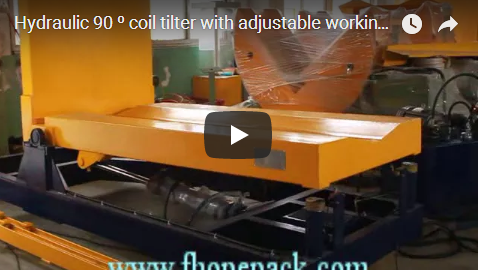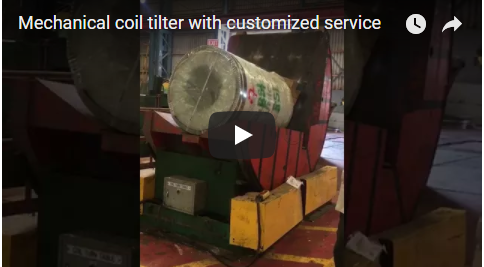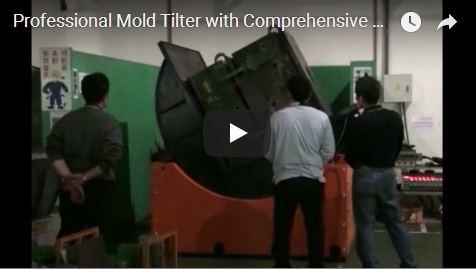Enhancing Efficiency and Safety: A Deep Dive into Steel Sheet Inverters and Turning Machines
Handling large, heavy stacks of steel sheets presents significant challenges in manufacturing and processing environments. Manual handling is often impractical and hazardous, while traditional lifting methods can be inefficient and risk damaging the material. The Steel Sheet Inverter and Turning Machine emerges as a critical solution, specifically engineered to address these issues by providing safe, controlled 180-degree rotation of heavy loads. This capability is essential for tasks such as removing shipping pallets, inspecting surfaces, or orienting sheets for subsequent processing steps.
1. The Challenge: Maneuvering Heavy Steel Sheets
Transporting, storing, and processing large steel sheets involves inherent difficulties:
- Weight & Size: Steel sheets, especially in stacked bundles, can weigh several tons, making manual or simple mechanical handling dangerous and inefficient.
- Damage Risk: Improper handling can easily lead to scratches, dents, or warping, compromising material quality and incurring costs.
- Accessibility: Accessing the underside of a stack for pallet removal or inspection requires a reliable method to invert the load without compromising stability or safety.
- Operational Bottlenecks: Slow or cumbersome handling processes can significantly impede production workflow and overall throughput.
2. Introducing the Steel Sheet Inverter & Turning Machine
This specialized piece of material handling equipment is designed to securely clamp and rotate stacks of steel sheets or other large, flat materials. Its primary function is to provide a full 180-degree inversion, enabling efficient and safe access to all sides of the load. Key applications include:
- Pallet Removal/Exchange: Easily removes or exchanges bottom pallets without manually lifting or disturbing the stack.
- Surface Inspection: Allows thorough inspection of both top and bottom surfaces.
- Process Orientation: Turns sheets over for feeding into specific processing lines (e.g., coating, stamping).
- Load Flipping: General purpose inversion for various logistical or manufacturing needs.
3. Core Functionality: The 180-Degree Rotation Mechanism
The machine operates through a precisely controlled sequence:

- Loading: The stack of steel sheets (often on a pallet) is placed onto the machine's loading platform or between its clamping arms.
- Clamping: Powerful hydraulic or electromechanical clamps securely grip the load from the sides or top/bottom, applying sufficient pressure to prevent shifting during rotation without causing damage. Clamping pressure is often adjustable based on load characteristics.
- Rotation: The main body of the machine, holding the clamped load, rotates 180 degrees around a central axis. This rotation is typically driven by a robust hydraulic motor or a geared electromechanical system, ensuring smooth and controlled movement.
- Unclamping & Unloading: Once inverted, the clamps release, allowing the removal of the pallet or access to the newly exposed surface. The inverted stack can then be removed from the machine.
(Above: Video demonstrating the operational sequence of a similar load inverter)
4. Key Design & Structural Components
A robust steel sheet inverter is built from several critical components designed for heavy-duty operation:
- Main Frame: Fabricated from heavy-gauge structural steel to withstand significant loads and rotational forces. Finite Element Analysis (FEA) is often employed during design to optimize strength and rigidity.
- Clamping System: Consists of arms or platens actuated by hydraulic cylinders or heavy-duty screws. Clamping surfaces may feature protective padding (e.g., polyurethane) to prevent material damage.
- Rotation Drive: Typically incorporates a high-torque hydraulic motor coupled with a heavy-duty gearbox or a direct electromechanical drive with a slewing ring bearing.
- Hydraulic Power Unit (HPU): (If hydraulically powered) Includes the motor, pump, reservoir, valves (directional, pressure control, flow control), filters, and hoses necessary to power the clamping and rotation functions.
- Control System: Features an operator panel (push-button or HMI) for initiating commands, emergency stops, and potentially programmable logic controller (PLC) for automated sequences and safety interlocks.
- Bearings & Bushings: High-capacity bearings are crucial for supporting the rotating structure and ensuring smooth, low-friction movement.
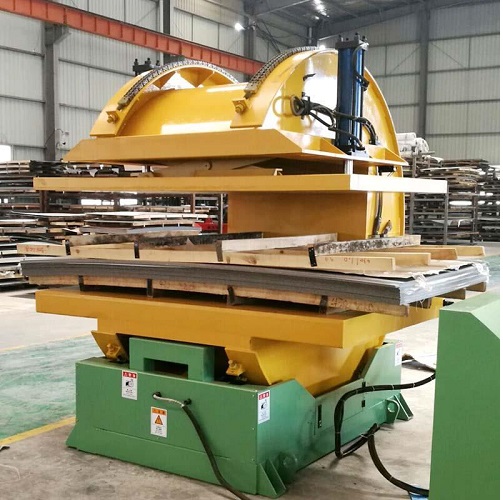
steel sheet pallet turning machine 5. Technical Specifications & Data Comparison
Specifications vary significantly based on application requirements. Here's a typical range and key parameters to consider:
| Parameter | Typical Range / Specification | Importance |
|---|---|---|
| Load Capacity | 1 Ton - 50+ Tons | Must match or exceed the maximum weight of sheets |
| Rotation Angle | 90°, 180° (standard) | Defines the machine's core function |
| Rotation Speed | 30 - 90 seconds per 180° cycle | Impacts cycle time and overall throughput |
| Clamping Method | Hydraulic / Electromechanical | Determines power source and control characteristics |
| Clamping Range | Variable (e.g., 400mm - 1600mm H) | Must accommodate the height/width range of loads |
| Platform/Opening Size | Custom (e.g., 1500x1500mm) | Needs to fit the footprint of the steel sheets |
| Power Requirements | 480V/3Ph/60Hz (typical US) | Electrical supply needed |
| Control Voltage | 24V DC | Standard for safety circuits |
| Machine Weight | 3 Tons - 15+ Tons | Foundation requirements, installation planning |
| Footprint (L x W x H) | Varies greatly | Space allocation within the facility |
Note: The machine featured in the initial video specifies a Max Loading up to 30T and utilizes hydraulic cylinders for clamping during the 180-degree turn.
6. The Hydraulic System: Power and Precision
For heavy-duty applications like the 30T model mentioned, hydraulic systems are often preferred due to their high power density and ability to generate immense clamping and turning forces smoothly.
- Force Generation: Hydraulic cylinders provide reliable linear force for the clamping arms.
- Rotational Torque: Hydraulic motors deliver the high torque needed to rotate multi-ton loads consistently.
- Control: Proportional valves can offer precise control over clamping pressure and rotation speed, preventing shocks and ensuring smooth operation.
- Durability: Hydraulic components are generally robust and well-suited for demanding industrial environments.
- Maintenance: Requires regular checks of fluid levels, filters, hoses, and seals to ensure optimal performance and prevent leaks. Further reading on hydraulic system maintenance (Example authoritative external link).
7. Operational Advantages & Applications
Integrating a steel sheet inverter offers tangible benefits:
- Enhanced Safety: Dramatically reduces risks associated with manual handling or less secure lifting methods. Eliminates personnel needing to be near suspended or unstable loads during inversion.
- Reduced Product Damage: Secure clamping and controlled rotation minimize the chance of scratching, bending, or dropping the steel sheets.
- Increased Efficiency: Significantly speeds up the process of pallet removal, inspection, or reorientation compared to manual or crane-based methods. Cycle times are predictable and consistent.
- Labor Savings: Reduces the manpower required for handling operations, freeing up personnel for other value-added tasks.
- Versatility: Can often handle various load types beyond steel sheets, such as molds, dies, paper rolls, or finished goods, depending on the design. Explore different types at Fhopepack Load Inverters. (Retained internal link)
8. Safety Features: A Non-Negotiable Design Element
Safety is paramount in the design and operation of such powerful machinery:
- Emergency Stop Buttons: Strategically located for immediate shutdown.
- Overload Protection: Hydraulic pressure relief valves or motor current monitoring prevent operation beyond rated capacity.
- Secure Clamping Interlocks: Rotation is typically prevented unless the load is confirmed to be securely clamped.
- Controlled Rotation Speed: Prevents sudden or jerky movements.
- Physical Guarding/Light Curtains: (Optional) Can restrict access to the operating area during rotation.
- Warning Lights/Alarms: Indicate machine status (e.g., power on, rotation in progress).
- Compliance with relevant safety standards like OSHA or ISO is critical. (Example authoritative external link).
9. User Experience & Maintenance Considerations
While designed for heavy industry, usability and maintainability are key:
- Ease of Operation: Intuitive controls allow operators to perform cycles efficiently with minimal training. HMIs can provide diagnostics and status updates.
- Loading/Unloading Access: Designed for easy integration with forklifts or overhead cranes.
- Routine Maintenance: Requires regular lubrication of bearings and moving parts, hydraulic system checks (fluid level, filter changes, leak inspection), and inspection of structural components and fasteners.
- Accessibility for Service: Well-designed machines provide reasonable access to key components like the HPU, drive motor, and bearings for maintenance and repair.
(Above: Example of another industrial load turning application, highlighting versatility)
10. Conclusion: A Strategic Investment in Efficiency and Safety
The Steel Sheet Inverter and Turning Machine is more than just a piece of handling equipment; it's a strategic asset for any operation dealing with large, heavy sheet materials. By automating the inversion process, it directly addresses critical challenges related to safety, material integrity, and operational speed. The robust design, often powered by reliable hydraulic systems, ensures longevity and consistent performance in demanding industrial settings. Investing in the right turning machine, specified correctly for load capacity and operational needs, yields significant returns through enhanced productivity, reduced waste, and a safer working environment.

